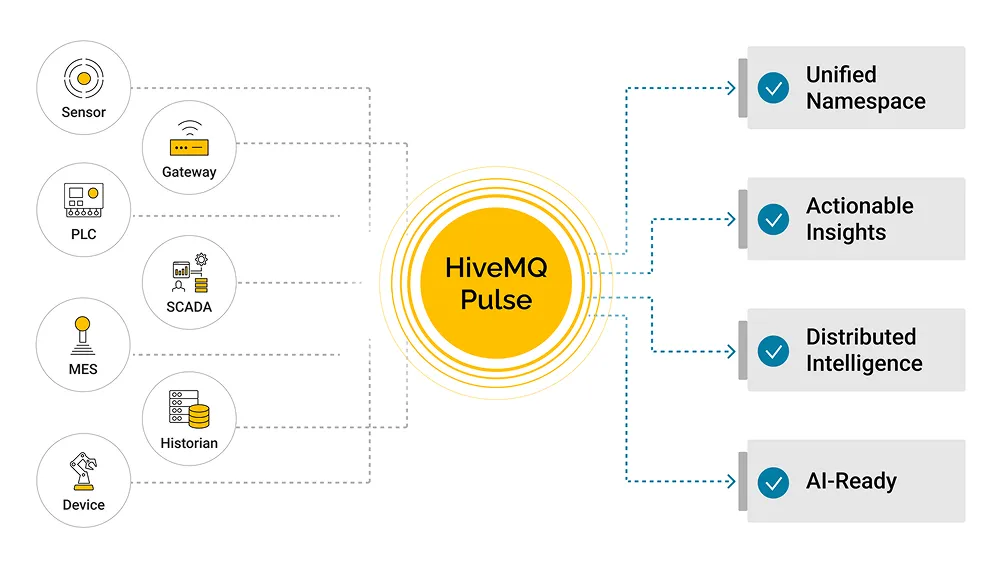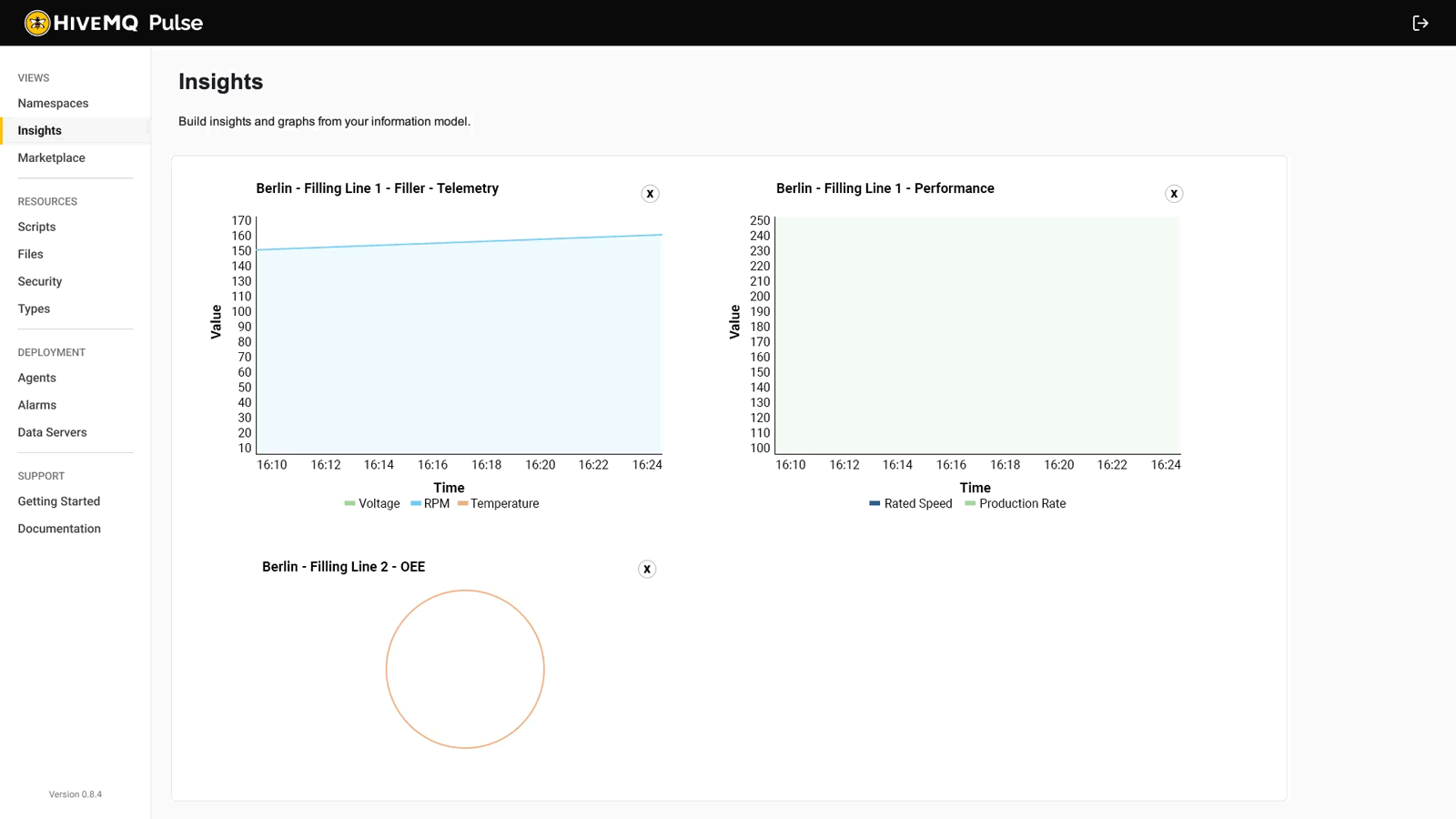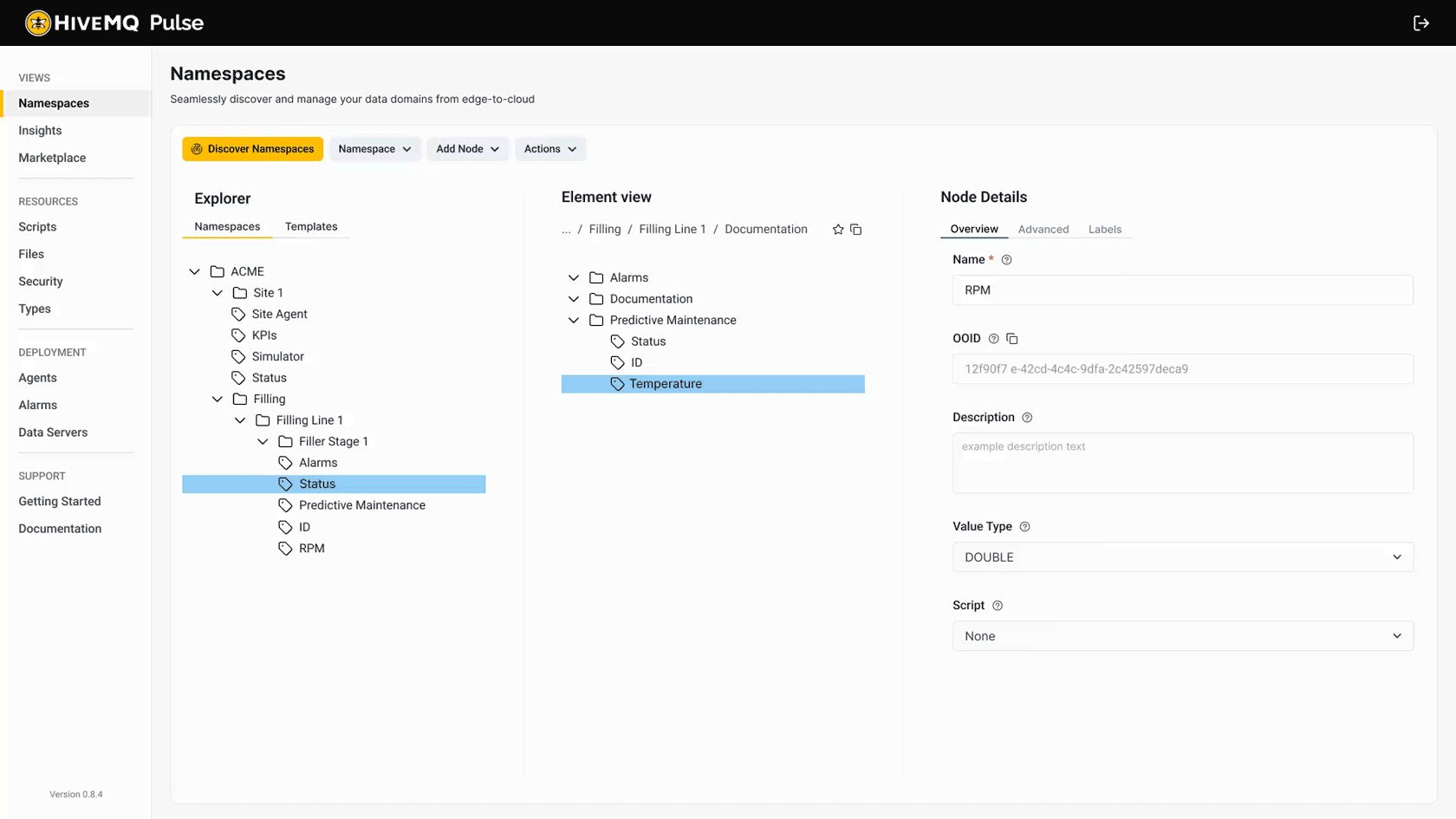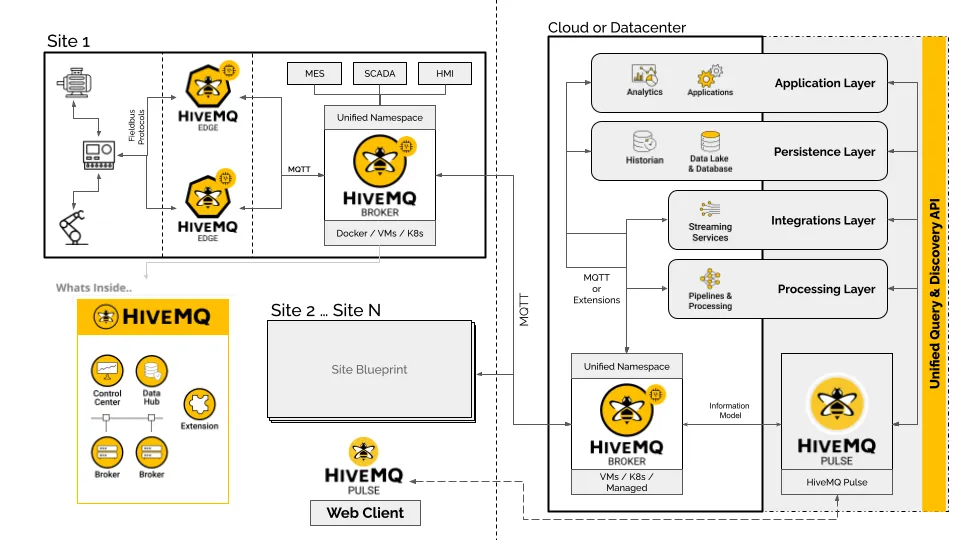Announcing HiveMQ Pulse: The Distributed Data Intelligence Platform
Over the past several years, there has been a fundamental shift in the requirements for data management. The old approach—rigid, hierarchical structures and siloed systems—can no longer support the demands of modern, data-rich use cases. There’s an ever-increasing demand for productivity, plus the constant pressure of training and retaining the talent needed to deliver on the promises of Industry 4.0 and beyond.
Over the last few weeks, we’ve been showcasing an approach that’s helping forward-thinking companies tackle these challenges: the Unified Namespace (UNS). We’ve learned how it should be understood, how to implement its foundational elements, and crucially, why a single technology or protocol alone (even MQTT) can’t fulfill everything a UNS promises.
HiveMQ has powered UNS implementations at some of the world’s largest energy, pharmaceutical, and logistics organizations. We’ve seen three persistent challenges: first, the difficulty of creating a truly unified, interoperable data model across diverse systems; second, the need for real-time on-location data insights that don’t require perfect connectivity or round trips to the cloud; and third, the pressure to ensure robust security, governance, and compliance at every step. Conventional bolt-on or proprietary platforms miss one or more of these needs, forcing enterprises to compromise.
We kept hearing the same questions from our customers: Can we get a real-time view of our operations, keep control of our data, and make sure the right people have access to the right information—whether at the edge or in the cloud? The short answer is “yes,” and it’s why we’re excited to introduce and announce a private preview of HiveMQ Pulse.
What is HiveMQ Pulse?
HiveMQ Pulse is a real-time, distributed data intelligence platform that delivers the best of both worlds—bringing intelligence to the edge for immediate decision-making while ensuring centralized governance and interoperability across the entire data ecosystem. It allows enterprises to manage, transform, and govern distributed data while maintaining a single, structured view of the enterprise. By historicizing and governing in-flight messages, enabling real-time queries and compute tasks, and applying contextual information, Pulse ensures that data is not only available but also actionable for AI and other critical use cases.
Why Enterprises Need Distributed Data Intelligence
Both IIoT and IoT data have increased in complexity with rapid growth in devices, legacy systems, and disparate data formats, making it harder for enterprises to unify their data in a structured, actionable way. Without a scalable, intelligent approach to managing this complexity, businesses risk falling behind.
Faster access to insights means faster time-to-market and greater ability to make adjustments that prevent downtime, reduce costs, and ultimately increase profits. Research shows that businesses operating in real-time environments achieve 62% higher revenues and make decisions 30% faster, proving that the ability to process, analyze, and act on data as it’s generated directly translates to business success.
 That’s why data-driven decision-making is no longer optional—it’s a competitive necessity. Industry leaders recognize that adaptability is key, and organizations that successfully harness real-time intelligence see measurable advantages. This is where HiveMQ Pulse comes in—delivering the unified data management, real-time insights, distributed intelligence, and AI-readiness that enterprises need to succeed.
That’s why data-driven decision-making is no longer optional—it’s a competitive necessity. Industry leaders recognize that adaptability is key, and organizations that successfully harness real-time intelligence see measurable advantages. This is where HiveMQ Pulse comes in—delivering the unified data management, real-time insights, distributed intelligence, and AI-readiness that enterprises need to succeed.

Unified Data Management
The Unified Namespace pattern has gained significant traction, and HiveMQ has worked with many customers to implement UNS at scale on our MQTT Platform. While MQTT is an ideal technology—and HiveMQ is the ideal broker—for transporting data reliably at scale, there is an absence of tooling for managing the metadata and context of a Unified Namespace. HiveMQ Pulse fills this gap by providing a structured way to manage UNS data transformations efficiently.
Since a UNS approach ensures that all data across an enterprise is organized under a single, centralized data structure, many companies mistakenly assume a data warehouse or traditional enterprise data platform can serve as their UNS. This is not the case. Unlike traditional architectures where transformations and data modifications are performed at individual sites or edge gateways, a UNS enabled by HiveMQ Pulse allows for changes to be made at the namespace level. The underlying system then orchestrates where those changes need to take effect.
For example, instead of manually modifying a data tag at a specific site, the user updates the Unified Namespace. The system then ensures the transformation occurs at the relevant location automatically, eliminating the need to interact with individual gateways. This declarative approach is core to HiveMQ Pulse, enabling it to autonomously determine the type and location of operations to execute when the namespace is modified.
Actionable Insights
Actionable Insights are real-time analytics and calculations that occur as close to the data source as possible, rather than relying on cloud-based processing. This ensures immediate feedback and response, reducing latency and dependency on centralized infrastructure.
For instance, an operational efficiency metric such as Overall Equipment Effectiveness (OEE) can be calculated on-site from existing performance, quality, and availability data without sending raw data to the cloud. This capability enables businesses to derive real-time insights and take corrective action instantly. The ability to generate and apply insights at the point of need is a fundamental shift in data intelligence.

Distributed Intelligence
Distributed Intelligence refers to the decentralization of computing power, ensuring that intelligence and decision-making occur at the appropriate edge locations rather than relying on a central processing hub. This architecture reduces bottlenecks, improves response times, and ensures resilience.
With a distributed intelligence approach:
The Unified Namespace is defined in a centralized plane, but the execution of logic, transformations, and processing happens at the local nodes.
Edge devices autonomously learn and execute tasks based on intelligence that is centrally defined but dynamically distributed, eliminating the need for explicit coordination.
For example, if a script for converting Celsius to Fahrenheit needs to run at a specific filling line, the system automatically determines where it should execute. The user does not need to specify the site or agent responsible for running it—the system handles the orchestration at the edge.

Powers AI
Powering AI means allowing for easy AI model integration and ensuring that data is contextualized, structured, and accessible in a way that supports AI and machine learning applications. The key aspects of an AI-ready system include:
Rich metadata: Every data point is tagged with units, context, and historical changes, ensuring AI models can properly interpret and analyze it.
Lookup capabilities: Data entries include IDs and relationships that allow for easy traceability and contextual understanding.
Future AI integrations: The system is designed to seamlessly integrate with AI models and automation tools by maintaining high data quality and integrity.
For instance, if a dataset containing machine sensor data is stored in a data lake, an AI model can quickly retrieve associated contextual information—such as units, location, equipment type, and past trends—to generate accurate predictions and recommendations.
Under the Hood: The Technology Behind HiveMQ Pulse
HiveMQ Pulse is based on a distributed architecture that overlays an enterprise MQTT deployment. The strength of HiveMQ’s proven MQTT platform is now coupled with an agent-based architecture that captures and shares insights across the enterprise.
 The HiveMQ Pulse distributed intelligence platform includes the following components in its deployment.
The HiveMQ Pulse distributed intelligence platform includes the following components in its deployment.
Pulse Server
Manages information models, authorizes Agents, and orchestrates queries. Scalable for policy enforcement, enables high-throughput processing, and seamless OT-IT integration.
Pulse Agent
Indexes and processes edge data with a distributed calculation engine. Filters, historicizes, and governs in-flight messages while enabling real-time queries and compute tasks. The agents can be deployed on/alongside standards-based endpoints and brokers.
Pulse Client
Secure web app/GUI for managing data models, policies, and queries. Supports UNS modeling, structured data interaction, and simple dashboards for actionable insights.
Together, these components deliver a truly seamless experience where the needs of users and those building and running advanced capabilities can be served equally effectively, and in a distributed manner.
Final Thoughts: A New Era of Distributed Data Intelligence Begins Today
As operations grow more complex, businesses need solutions that don’t just collect data but make it immediately useful—without sacrificing security, governance, or flexibility. HiveMQ Pulse is built to address exactly that need. By delivering real-time intelligence at the source, ensuring data sovereignty, and enabling seamless edge-to-cloud governance, Pulse represents a fundamental shift in how data is accessed, processed, and acted upon.
With unified data management, actionable insights, distributed intelligence, and powering AI use cases, HiveMQ Pulse is more than just a UNS enabler—it’s a new way to think about data architectures. It eliminates data silos, creates true IT-OT convergence, and empowers teams with real-time visibility, ensuring enterprises are ready for the AI-driven future without unnecessary complexity.
Now is the time to move beyond bolted-on, centralized, and reactive data solutions. The industry is changing, and businesses that can act on insights faster, ensure resilience, and maintain control over their data will have the competitive edge.
Get Started with HiveMQ Pulse
HiveMQ Pulse is now available in private preview. Sign up today to explore how it can revolutionize your data strategy.

Gaurav Suman
Gaurav Suman, Director of Product Marketing at HiveMQ, is an electronics and communications engineer with a background in Solutions Architecture and Product Management. He has helped customers adopt enterprise middleware, storage, blockchain, and business collaboration solutions. Passionate about technology’s customer impact he has been at HiveMQ since 2021 and is based in Ottawa, Canada.
